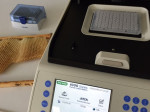Application of marker-assisted selection for Varroa tolerance in the honey bee
| Funding code: | 03HS041 | |
| Acronym: | ||
| Involved employees: | Dr. M. Brink, Andrea Jäkisch, Prof. Dr. K. Bienefeld | |
| Co-operation partners: | INRA Gif-Sur-Yvette, Frankreich | |
| Duration: | 2004 - 2006 | |
| Financing: | German Federal Ministry for Consumer Protection, Nutrition and Agriculture (BMVEL) |
Due to the strong environmental dependence, resistance acquisition, reproductive and genetic peculiarities of the honey bee, costly resistance tests and the small-scale business structure of German apiculture, traditional breeding programmes for this species are in need of support. In this project, marker-assisted selection already successfully applied in other livestock species is to be initiated for the honey bee and its feasibility for this species is to be investigated.
The trait "removing Varroa-parasitised brood" is to be used as a selection criterion, since it plays an important role in Varroa tolerance and secondly because individually labelled single bees are observable with a method developed at LIB (infrared video observation). For the molecular genetic analysis, this results in favourable conditions since unique individual trait expression does exist under standardised conditions. Using 245 microsatellites, an initial rough mapping of QTL for Varroa defence is to be undertaken. In the future, marker-assisted selection could allow for the selection of Varroa-resistant queens by means of DNA analysis without having to subject them to heavily environmentally determined and time-consuming performance tests.
Publications:
- Brink, M., Zautke, F.; Solignac, M.; Bienefeld, K. (2006) Genetic analysis of the hygienic behaviour towards Varroa destructor infested brood. Apidologie 37(5), 641 - 642
- Application of marker-assisted selection for Varroa tolerance in the honey bee
- Utilisation of gene expression differences in hygienic and non-hygienic working bees towards Varroa-parasitised brood for the selection of generally disease-resistant honey bees
- Marker-assisted selection of the honey bee for Varroa tolerance by fine mapping and identification of causative genes in relevant genomic regions


